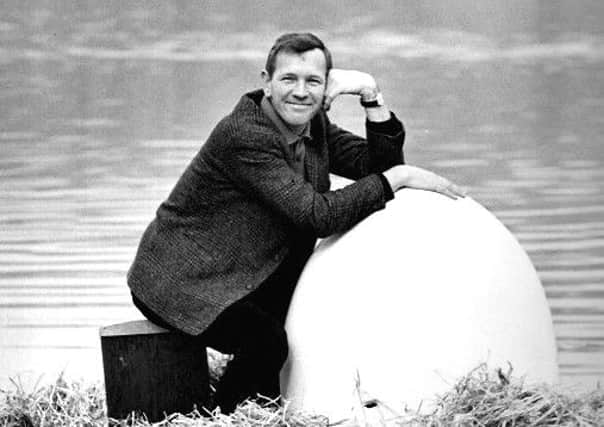Obituary: Kenneth Partridge, interior designer


Kenneth Partridge worked on television’s first home makeover show and wrote about how to style a bedsit, but was best known as the doyen of interior design for his outlandish work for British celebrities of the psychedelic swinging 60s and 70s, including three of the four Beatles and their manager Brian Epstein.
By the time Partridge took on one of his biggest projects, the complete “carte blanche” renovation of John Lennon’s 22-room, mock-Tudor mansion, Kenwood House, in Weybridge, Surrey, the charming, witty, bubbly and occasionally outrageously outspoken Partridge had already established himself as one of the go-to designers of the era for those with wherewithal to have their fantasies realised.
Advertisement
Hide AdAdvertisement
Hide AdLennon was introduced to Partridge at Epstein’s penthouse in Knightsbridge at a celebrity-packed “send-off” party for the Beatles first tour of America, commencing in August 1964. The rapport was almost instant with Lennon in awe of Partridge’s transformation of his manager’s apartment; he had also constructed a marquee on the rooftop with plush red carpets. He was hired on the spot to work on Kenwood.
Within 24 hours, Partridge had produced colour schemes for 18 rooms with swatches of fabrics; Lennon, who is said to have simply considered the house as a “stop-over on the way to something better,” gave them a cursory glance at the details and gave him the nod to give the house a no-expenses-spared makeover.
Cynthia Lennon later recalled, “We lived in the top flat while the rest of the place was being totally gutted and redesigned… We couldn’t believe it: I mean, it was dead posh in our terms.”
Over the next nine months, Partridge re-designed the house with extensions and the removal of walls to create his vision of how a “1960s nouveau riche pop star” should live. He went on to spend nearly twice the original purchase price on renovations, reducing it in size from 22 rooms to 17, landscaping the 1.5 acre gardens and adding an outdoor swimming pool.
Later journalist Maureen Cleave, interviewed Lennon at the house, and wrote, “His sitting room had yellow tartan wallpaper. It had been done over by somebody and it was mock-absolutely-everything-you-can-think-of.”
During the following four years, Beatlemania was relentless and Ringo Starr and George Harrison bought houses nearby, while Paul McCartney drove in from London for regular song writing sessions. The house sold in 1969 for £40,000 to Bill Martin writer of the Eurovision hits Puppet on a String sung by Sandie Shaw and Cliff Richard’s Congratulations. The house changed hands several times, selling for £5.8 million in 2007 and went on the market for £13.5m in 2014.
Born in the working class south London suburb of Brockley in 1926, Kenneth Alexander Partridge was the son of an electrical manufacturing manager father and a housewife mother; he had a sister called Sheila. Educated locally, the family then moved to St Mary Cray, Kent, in the mid-1930s. Partridge finished secondary school, studying at Bromley College of Art, before securing a position with the beauty products company Elizabeth Arden on Bond Street, where he worked on window displays.
With the outbreak of the Second World War in September 1939, soon after Partridge found himself working for a spell as a Bevin Boy in the coal mines. He then completed a two-year National Service in the RAF.
Advertisement
Hide AdAdvertisement
Hide AdBy the 1950s, he had returned to London dressing windows at the upmarket department store Simpsons in Piccadilly before moving on to the classic “twinset and pearls” image of Jaeger on Regent Street.
In 1964, with the move of the revered Sekers Fabrics, which had sold British fabrics to the French couture houses, from Bruton Street to its new premises in Sloane Street, London W1, Partridge was invited to oversee the presentations and displays. By this time Partridge had already met Brian Epstein and accompanied him to private gambling clubs in London. “He loved the danger,” he said.
Working in celebrity circles, Partridge designed shows for prominent fashion designers to the Royal household, Sir Norman Hartnell and Sir Hardy Amies - the Queen’s official dressmaker from 1952 until his retirement in 1989. Further work for and a close friendship with Sir Laurence Olivier was similarly formed.
Partridge’s main love was producing outlandish, extravagant parties. One of his most spectacular was the 80th birthday of the couturier, socialite and inventor of Capri pants, Neil “Bunny” Roger in 1991; he created a swirling vision from Dante’s Inferno with Roger emerging through fire to greet his 400+ guests, and Partridge, red-suited and armed with a trident, in the role of attendant devil.
In retirement, Partridge became a prison visitor, working for the charity founded by Lord Longford; he spent several years looking after his long-time friend, the singer Elisabeth Welch, before her death in 2003.
Partridge is survived by his sister Sheila and his partner of 66 years, the writer and television producer Derek Granger.